
How to Plant, Grow, and Care For Begonias
| Botanical Name |
Begonia |
| Plant Type |
Tuber |
| Sun Exposure |
Full shade to partial shade |
| Soil Type |
Well-drained acidic, clay, loamy or sandy soils |
| Soil pH |
Slightly acidic |
| Bloom Time |
Summer to frost |
| Flower Color |
White, yellow, pink, red, orange |
| Hardiness Zones |
3, 4, 5, 6, 7, 8, 9, 10 (lift in zones 3-8) |
| Special Features |
Popular for hanging baskets, begonia's bright flowers brighten shaded patios and gardens. |
One of the most popular, shade-loving plants for hanging baskets and containers, begonias are known for their bright flowers and long flowering period. These tender perennials are also planted as bedding plants. Used to symbolize gratitude and peace, begonias are available in an array of colors, including white, yellow, pink, orange and red hues. Their habit may be upright or trailing.
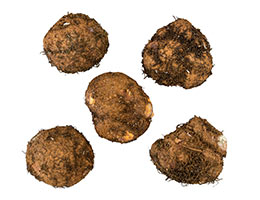
How to Plant Begonia Tubers
Plant begonia tubers round side down and about 1" below the surface. Water well and keep in a warm, semi-shady area. Since tuberous begonias are tender bulbs, you'll want to wait until after the last frost to plant outdoors. Or you can start begonias indoors to get a head start. In garden settings, begonias should be spaced 12" apart. In containers, they should be spaced 4-5" apart. Once the plants start growing, begonias benefit from an all-natural, slow-release plant food, such as
Van Bourgondien 100% Natural Bulb Food.
When to Plant Begonia Tubers
To be ready for planting season, many gardeners buy begonia tubers online in late winter to early spring. Many northern gardeners will start begonia tubers indoors about six weeks before the last spring frost in their area. The begonia plants are then transplanted to the garden or moved outdoors after the danger of spring frost has passed. While begonia tubers can be planted outdoors after the danger of frost has passed, they may not bloom until late summer or early fall in northern areas of the country. In more southern regions, begonia tubers may be directly planted outdoors in containers or the garden.
Where to Plant Begonias
Begonias are tender perennials, and can overwinter outdoors in zones 9-10. Gardeners in zones 3-8 either grow begonias as annuals or lift the tubers in the fall and store them indoors over winter. To determine, your grow zone, use our hardiness zone map.
Begonias are shade-loving plants and grow best in filtered or full shade. Most varieties don't like the hot afternoon sun. Begonias also perform best in well-drained, slightly acidic soil. If planted in poorly drained soil, their tubers may rot. To improve your soil drainage, add compost, peat moss, loam or sand.
How to Grow Begonias
Most begonia varieties prefer consistently moist soil. Don't allow the soil to dry out between watering, but also don't overwater. Most begonias thrive in cool, shaded environments. Make sure the plants are protected from the hot afternoon sun and high winds. Be sure to remove dead flowers for better blooming capabilities.
Growing Begonias Indoors in Containers
Many gardeners bring begonias indoors in the fall and overwinter them as houseplants. Others grow begonias indoors year-round. To plant begonia tubers in containers, you'll need a high-quality potting soil and containers with good drainage. Space begonias 4-5" apart in containers.When growing begonias indoors, allow the soil to dry slightly between watering. Because indoor settings often have lower humidity than outdoor summer settings, set the pots on a tray with pebbles, so the pots are sitting above, not in, water. Avoid placing your begonia plants near heater vents. Your begonias will need some light, and often windows facing the east, west or south are the best. You can also use grow lights.

End of Season Care for Begonias
Propagating Begonias
One of the joys of gardening is sharing plants with friends. Tuberous begonias are propagated by cuttings. In the spring, separate the newer side plants and replant with fresh soil.
Overwintering Begonias
Begonias can overwinter in the garden in zones 9-10. Gardeners in zones 3-8 can grow begonias as annuals, dig up the tubers in the fall and store them in a frost-free location, or bring begonias indoors and treat as houseplants.
Saving Begonia Tubers
To save begonia tubers over winter, wait until after the first fall frost. Then dig up the tubers and cut the stem away from the tuber. Allow the tuber to dry or cure for about a week, and then store the tubers in a paper bag in a cool location, such as a basement, during winter. Do not allow the tubers to freeze.
Begonia Plant FAQs
How Long do Begonias Bloom For?
Begonias bloom from summer until the first frost in the fall.
Is a Begonia a Perennial?
Begonias are tender perennials, meaning they can overwinter outdoors in zones 9-10. In zones 3-8, they must be brought indoors or the tubers must be dug up from the garden.
What Colors do Begonias Come In?
Begonias are available in a wide array of flower colors. Common ones include white, pink, red, yellow and orange.
What are Common Pests and Diseases Associated with Begonia Flowers?
In humid conditions with poor air circulation, begonias may develop powdery mildew, botrytis and stem rot. If overwatered or if planted in poorly drained soils, the tubers may rot. Pests that may be problematic for begonias include aphids, whiteflies and ealybugs.
Varieties of Begonia Flowers
When selecting begonia flowers for planting, you have many color choices as well as plant habits. Here are some of the most popular begonias to grow.
 Non-Stop Begonia Mixed
Non-Stop Begonia Mixed This random mix of red, orange, pink, yellow or white flowers features medium-sized, double flowers on vigorous plants that grow just 8-10" tall. Their dwarf habit makes them wind resistant--and ideal for bedding and container plantings. They bloom from June to frost.
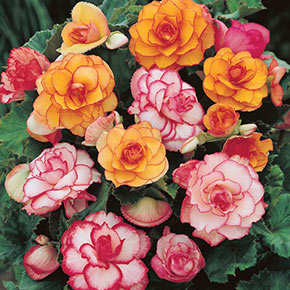 Picotee Begonia Mixed
Picotee Begonia Mixed Showy, heavily ruffled, camellia-like double flowers are up to 6" across--and their color is spectacular. This random mix of yellow flowers edged in pink-red, white flowers edged in pink-red, or red flowers edged in white look outstanding in hanging baskets, patio containers and window boxes.
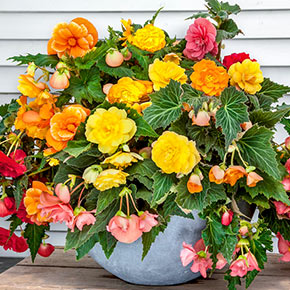 Double Hanging Basket Begonias Mixed
Double Hanging Basket Begonias MixedNon-fading flowers and a cascading habit make this mix an outstanding choice for hanging baskets and window boxes. From world-famous Belgian bulbs, this is the finest strain of hanging basket begonias available. The fully double flowers in white, pink, apricot, yellow or red, are stunning--and they bloom from July to frost.
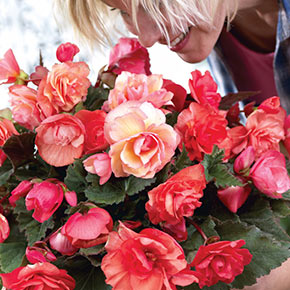 Fragrant Double Begonia Odorosa
Fragrant Double Begonia OdorosaDelight the senses with this uniquely fragrant begonia. Featuring double, cascading flowers in many shades of pink and apricot and green foliage distinctively marked with bronze, it blooms from July to first frost. It's a top choice for hanging baskets.
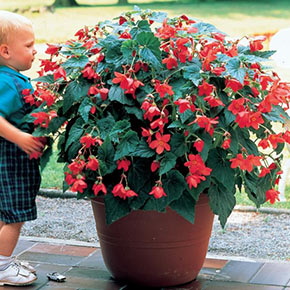 Skaugum Begonia
Skaugum BegoniaCreated in Norway and named after the castle where the King of Norway lives, this incredible begonia offers spectacular fiery red flowers on a large plant. Just one bulb will fill a tub planter with an abundance of blooms all summer long! Blooms from July to frost.
Have another question? Return to the Customer Service Help page or send an e-mail directly to Customer Service
 MENU
MENU Plant Finder
Plant Finder
 Help
Help












